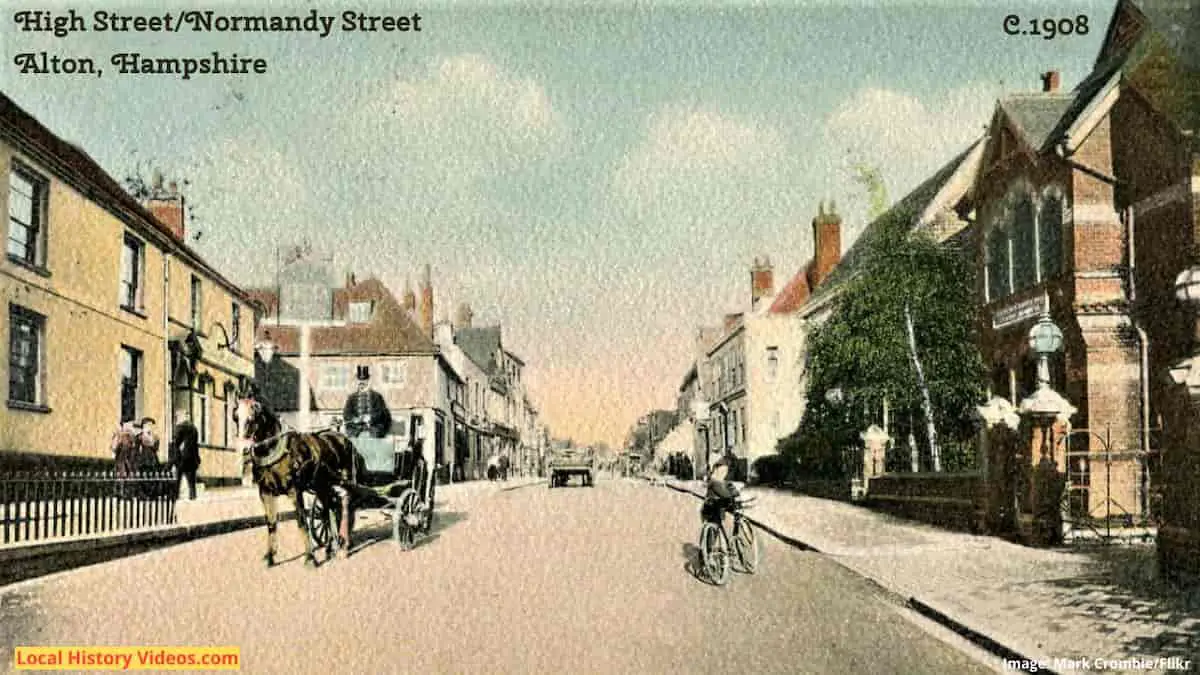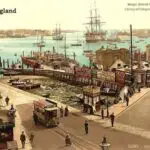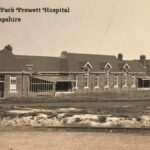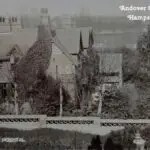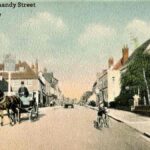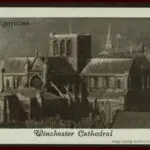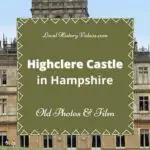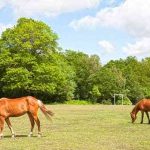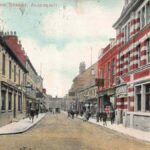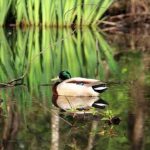Glimpse history through old images of Alton, Hampshire, England.
The Treloar School and College is a special independent school for pupils aged from 2 to 22 with physical disabilities.
It has long attracted attention from newsreels, albeit using language and showing attitudes about disabled people that we wouldn’t accept today.
As Lord Mayor of London, Sir William Treloar established a “Cripples’ Fund” as his mayoral appeal. He gained 10,000 pounds of donations for his Alton Hospital during his tenure as Lord Mayor of London 9 November 1906 to 1907, and welcomed the first children at Alton railway station on 8 September 1908.
1907-1910
Almost half an hour of early footage shows the children and staff at the new facility, along with a very jolly Sir William enjoying everyone’s company. Then we see the work of the staff and perseverence of the children.
Sir William Treloar Reel 2 (1907-1910) – British Pathe on YouTube
Sir Treloar’s Visit (1923)
Silent, black and white footage records a visit Sir William Treloar (13 January 1843 – 6 September 1923) made to the school in 1923. He died later that year on 6 September, aged 80.
Sir William Treloar visits children with disabilities in Alton (1923) – British Pathe on YouTube
Father Christmas (1927)
Silent, black and white footage shows the fun and games of Christmas activities for the children.
HEALTH / CHRISTMAS: Father Christmas visits the Lord Mayor Treloar Hospital (1927) – British Pathe on YouTube
Bernard Mulevu (1964)
Bernard Mulevu from Kenya was left disabled at the age of 2 after suffering from polio, an infectious disease which affected both adults and children before the introduction of vaccines.
Realising he had to earn a living, he crawled for several miles to a trade school to learn how to make shoes. An exemplary student, he was recommended for further study in the UK, and his two year place was funded by a Commonwealth grant.
REWARD FOR COURAGE – British Movietone
Alton 1993
A home video was recorded in 1993 by a “£10 Pom” from Sydney visiting the locations they knew from a 3 year period living locally in the 1970s.
This is a great video. Firstly, you get to see the streets, businesses, cars, and people of 1993. But in addition, there are a few labels telling you about these same locations back in the 1970s.
Alton Hampshire England – early 1993 – AngelStation on YouTube
A Bit of Alton History
Extract from “A Short History and Description of the Town of Alton in the County of Southampton” by William Curtis
Published in 1896
Pages 121-126
COACHES
” Till the beginning of the 18th Century we were almost wholly an equestrian people. Coaches began to be used somewhere about 1650. Pack horses and carriers ‘ waggons for many years were the only conveyances for merchandise and passengers. Stage coaches appear to have been in use soon after the middle of the 17th century, but then progress was very slow. In the south of England we made more rapid strides towards perfection; and it was to its position on the great highway from Gosport to London, that Alton in former times owed much of its prosperity, for in the old coaching days the traffic was very considerable.”
An interesting engraving of one of the coaches which used to run on this road, may be seen in the first volume of The Land we Live in. It was called the ” Alton Machine, ” and in 1750 left our town at six o’clock every morning, reaching London the same night. This was then considered a marvellous feat.
The Alton Machine was an immense clumsy vehicle, drawn by six horses, the coach man had four horses in hand, and a postillion rode a pair of leaders. The half – price passengers were not carried on the roof, but in a large basket, literally a basket, swung behind. The name ” machine ” became common, and hence stage coach horses were called ” machiners. “
During the early part of this century a number of coaches passed through this town; three up and three down each day between London and Southampton, and London and Gosport. Two were called ” The Age, ” two ” The Times, ” and two ” The Red Rover. ” There was also a private coach, driven by Mr. Yalden, to London one day and back the next; also two night coaches, one of which carried the mails.
Heavy road waggons for goods and merchandise, drawn by six or eight horses, travelled three or four times a week between London and Southampton.
Sixty or seventy years ago the mails were carried from Farnham to Alton by post horses ridden by post boys in blue jackets.
STOCKS AND TURNPIKE GATES
Stocks and a Whipping Post formerly stood at the end of the old Town Hall, and also at Anstey, on a little piece of ground near the turning to Anstey mill.
A Turnpike gate stood near Dr. Stewart’s house, but it was removed about 60 years ago to the vicinity of the Butts, in the position of the present drinking fountain.
Another stood at the end of Lenton Street; but it was removed about the year 1845 to Willhall Cottage, when the new Odiham road was completed; and a toll bar stood at Wyard’s end of Whitedown Lane.
MACADAMIZED ROADS
The high road from London to Gosport was made firm and good by a man named Macadam, who invented the process in the year 1819. The road – way was trenched to a certain depth, and all the large flints and gravel were broken small enough to run through a wire netting, or sieve, of a certain mesh. The ground was made good, and these broken stones placed on the top and well rammed.
Miss Jane Curtis informs me that she remembers the time when this was done throughout the town, and that it proved a very formidable undertaking. She also remembers seeing Macadam, and knows that her father had frequent talks with him. This was the origin of ” Macadamised Roads. “
I have heard my father say that he was always given to understand that originally Normandy Hill was much deeper and more hollow than it is now, and that there was a bank covered with bushes, sloping down from the foot path, and that Old Mr. Woodman, the builder, who lived in Nether Street, went bird nesting on this bank when a boy ( between 1790 and 1800. )
MANUFACTURES
” The old manufactures of Cloth and Silk survived in this County until the present century. About 100 years ago a brisk trade was carried on at Alton in plain and figured baragons ( a genteel corded stuff ), serges, white yarn, tabinets, bombazines, ribbed druggets and other woven fabrics, which found their principal market in America, and were much in demand in Philadelphia and its neighbourhood.
At the same time shalloons ( blankets ) were made at Andover, and worsted yarn was spun in the villages round Alton. The silk manufacture was at the same time carried on profitably at Overton, Whitchurch, Andover, Alton and Odiham. “
” The Cloth made in Hampshire formed an article of commerce with the Venetians from the 12th to the 16th centuries, and was bought by them and shipped at Southampton. The festival of Bishop Blaise, the patron Saint of Clothworkers, has been celebrated at Alton within the last 100 years, and also at Andover. “
There was a Fulling Mill at Alton, called Orp’s Mill, situated at the bottom of Crown Close, by the stream running into King’s pond, and another at Millcourt, Froyle.
This Mill in 1600 was bought by the Henry Wheeler of that time. The cloth was brought from the loom, soaked in lye – fullers earth soaped – put into the fulling mill, and then worked dry until thick enough. Water was then turned on to scour the cloth; the mill drew the serge or cloth in and out with huge timbers notched like teeth. When thus scoured the Cloth was dried in racks, strained out, and large fields were occupied in this way. When dry all knots were picked out and the Cloth folded with paper between each fold; after which it was put in screw presses, the first hot, the second cold.
Fuller’s earth was found at Churt, and the mill no doubt served the Clothiers of Alton and Farnham. There was a great deal of local industry then and for a hundred years later.
Wool was spun at home and found a market close at hand.
Hop bagging was also manufactured here, and I can recollect seeing one or two looms at work in a room or store in Market Street.
Hollow turning was carried on, principally in the shape of wooden shaving boxes and bowls. There is a cellar window in a cottage ( next to what is now Mr. Blake’s foundry ) which I found most attractive when a small boy, as I stood outside and watched the chips fly, while the old man, Ayling, worked at his turning.
There was also a ” Walk ” for manufacturing String at the back of the cottages on the top of Paper Mill Lane, and many a call we made on the old man, Palmer, to buy our string and whip – cord.
A little farther on, opposite Littlefield Road, stood an old shed outside a cottage, occupied by a man named Alwork, who made and repaired Cricket Bats.
At one time there was a Tanyard situated at the foot of Vicarage Hill, on the premises now occupied by Mr. Coleman and Messrs. Hetherington, one in Turk Street, on the site of Culverton House, and another was in existence during 1700, at the house in Lenton Street, now occupied by Mr. Burrell, and can only have been closed within the last thirty years.
FRENCH PRISONERS.
During the Peninsular War, in 1814, the French prisoners often travelled through the Town and were some times quartered in an old building at the back of the Crown Inn.
There was an opening or grated window looking into my Grandfather’s garden, the remains of which are still to be seen, and through this my Father and some of his Sisters used to give the prisoners food and buy from them quaint carvings of bone.
One of them made a hole through the wall and escaped by way of the garden to Great Wood, where he was captured.
In the following year, 1815, when peace was proclaimed, the event was celebrated by a public dinner in the High Street.
RIOTS.
” During the latter part of the Eighteenth Century the agricultural population of the County was in a distressed condition. Labour was abundant, work was scarce in winter, and wages low.
The only County Schools were those known as Charity Schools. The bulk of the agricultural population of Hampshire remained practically untaught, and consequently when labour saving appliances, such as the thrashing and turnip cutting machines, etc., were first introduced, the labourers ( who found employment in winter in threshing corn with the flail, as their forefathers had done from Saxon times downwards ) were too ignorant to see anything in such an innovation except ruin for themselves and their families, and riots occurred in some places, in which the machines were smashed and other acts of lawlessness were committed. “
My father used to tell us of the excitement in the County on the introduction of machinery for agricultural purposes, and the general depression ending in Bread riots, about the year 1830. On one occasion he was riding on one of his rounds, through East Worldham, on his way to Kingsley, when he was met by a large crowd of excited rioters, who stopped him at the top of Worldham Hill, and said, ” Oh, Mr. Curtis, it is a pity you were not at Headley when we broke into the Workhouse. You would have laughed if you had seen the tiles fly. Tell the people in Alton to look out as we are intending to attack the Workhouse and Breweries after we have been to Selbourne. ”
My father on his return home made known what he had seen and heard.
A messenger was sent on horseback to Winchester for troops, and a number of the inhabitants were sworn in as special constables; the town was patrolled at night, and every precaution taken against an attack.
The guardroom was an old hop store used by the Messrs. Crowley, and situated at the corner of Turk Street. The pockets of hops were ranged round in front of the fire place as seats for the comfort of the night watch, and my father ended his exciting reminiscences by saying, ” Didn’t I get a welcome there, as the bearer of sausage rolls and home made ginger bread nuts. “
Mr. Cassell, one of the oldest inhabitants of our town, informed me that a troop of Life Guards came from Winchester, and were quartered at the Crown Inn. They went to Selbourne, when the rioters set fire to a public house, and a barn at Newton Common, after which they became disorganized, and did not attack the town.
It is quite evident that at the time of which we are writing local information was not easily transmitted to any considerable distance, and in consequence we find very little information in the newspapers of that period with regard to these events. The only paragraph of interest is the following in connection with Holybourne, dated November 29th, 1830:
” At Holybourne, near Alton, the labouring classes assembled for the purpose of obtaining higher wages, stating that the present allowance was really insufficient to support their families. The farmers met, and agreed to give reasonable price for labour, with which the men appeared perfectly satisfied, and returned to their work. It is gratifying to observe that the conduct of the men towards their employers was orderly and respectful. They declared they did not intend to join with any persons not belonging to this parish, and only requested as much as would enable them to live. “
More about Hampshire
- Old Images of Hampshire, England
- Old Images of Bordon, Hampshire
- Old Images of Basingstoke, Hampshire
- Old Images of Andover, Hampshire
- Old Images of Alton, Hampshire
- History in Old Images of Winchester, England
- History in Old Images of Portsmouth, England
- Old Images of Southampton, England
- Old Images of the Bygone Port of Southampton
- Old Images of the Army at Aldershot
- Old Images of Highclere Castle
- Vintage Film Of Highclere Village
- Hampshire: Local History Resources
- Old Images of Aldershot, Hampshire: History in Film
- Schools In Fleet & Church Crookham: Old Videos
- Old Images of Fleet, Hampshire

